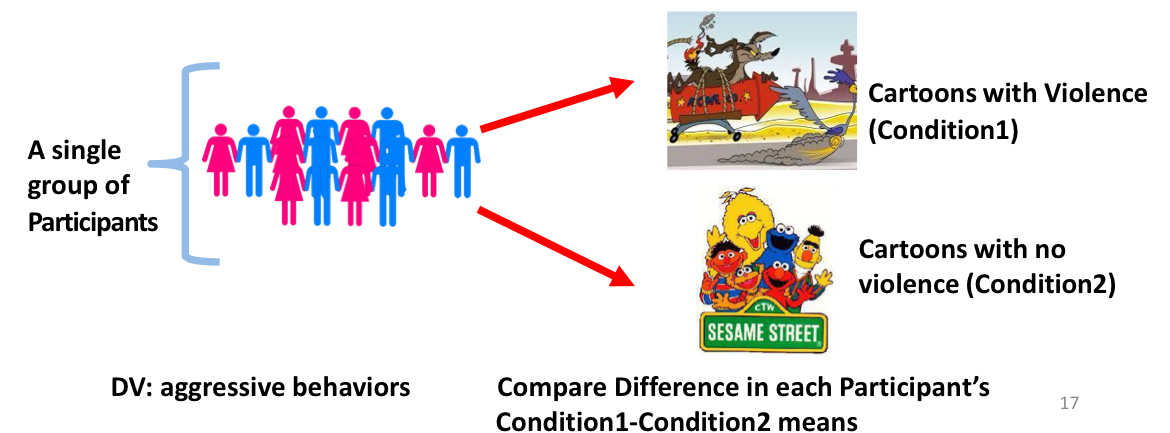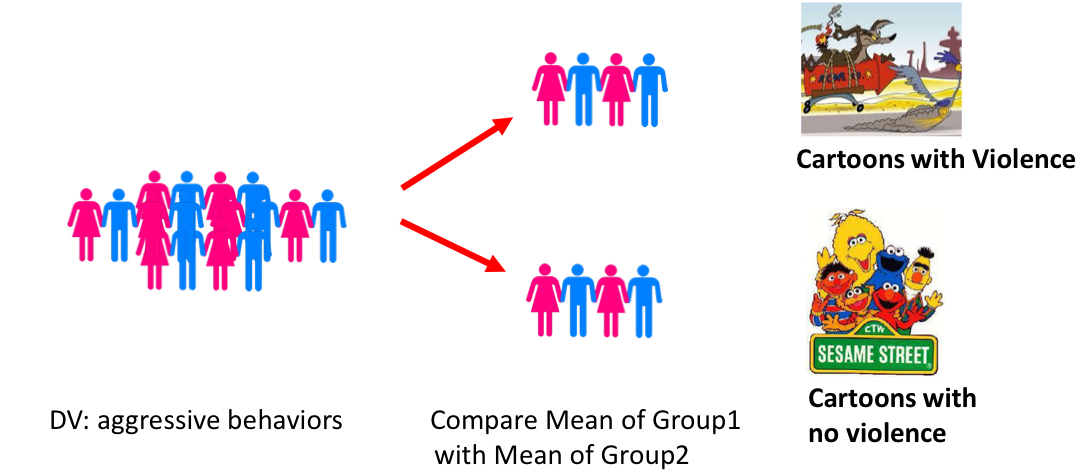Lecture 15: the experimental research strategy
1/41
There's no tags or description
Looks like no tags are added yet.
Name | Mastery | Learn | Test | Matching | Spaced |
|---|
No study sessions yet.
42 Terms
define “experimental design”
planning a set of procedures to investigate a relationship between the IV and the DV
what do you need to design a controlled experiment? (3)
testable hypothesis
at least one IV that can be precisely manipulated
at least one DV that can be precisely measured
what do you need to decide when designing an experiment? (4)
how the IV(s) will be manipulated
how to control for potential confounding variables
how many participants/samples will be included
how many participants will be assigned to conditions
what do you need to consider when building an experimental design?
internal and external validity
why is the experimental strategy the most powerful research method?
it has high constraints on variables: you manipulate the IV to demonstrate its effect on teh DV while holding other potential influences constant
what's the goal of an experimental design?
to arrive at a causal explanation about impacts of IV on DV
how can you demonstrate a cause-and-effect relationship with the experimental design? (2)
establish that the effect happens after the cause
establish that the IV is responsible for the change in the DV and not an extraneous variable
what are the situations/conditions you compare?
present VS absent: condition with treatment VS without treatment
how can you try to establish causlity?
strict control: create an unnatural situation where variables are isolated from the influence of other variables
true or false: only the experimental design can establish causality
false: quasi-experimental too
it’s impossible to prove causality, but what can we do?
show its likelihood relative to chance (alpha: alpha% of chance that it happened by chance)
*you don’t say that there is a cause-and-effect relationship, you say that the likelihood that this relationship happened by chance is alpha%
what do you need to establish to show if two variables are causally related? (4)
time-order: cause (X, IV) happened before effect (Y, DV)
covariation: change in the IV/X must be accompanied by changes in the DV/Y
rationale: logical explanation for why the two variables are related
non-spuriousness: only the IV/X can cause changes in the DV/Y
define “time order”
the IV/X (cause) must have occured before the DV/Y (effect)d
define “covariation” (AKA statistical association)
changes in the IV/X must be accompanied in changes in the DV/Y
define “rationale” (AKA explanation)
there must be a logical and compelling explanation for why these two variables are related
define “non-spuriousness”
only the IV/X can cause the changes in the DV/Y
*spurious: false, inaccurate
what are the types of experimental strategy? (2)
between groups: 2+ samples are formed and are assigned to different conditions/IV
within-groups: one sample and goes through all conditions/levels of IV, across time
what’s the difference between an IV, an DV and an extraneous variable?
IV: cause, manipulated
DV: effect, outcome, measured
extraneous: any other variable in the study
between-subjects or within-subjects:
IV = lessons
Treament: music lesson
Control: no lessons
between: there is a control condition, only in between
between-subjects or within-subjects:
IV = time of testing
DV = change in intelligence test scores from before-lessons to after-lessons
within: we look at the difference across time
define “within-groups designs”
one sample and all participants go through all conditions (levels of IV)
we compare the results across conditions within the same participant
*usually across time
image

define “between-groups design”
2+ samples composed of different participants that will go through different conditions
we compare the results between the groups
image

what are the groups that we only and always find in between-group designs? (2)
experimental group: group that will be exposed to an experimental manipulation
control group: group that isn’t exposed to the manipulation, will be used for comparison purposes
define “experimental group”
group that will be exposed to experimental manipulation
define “control group”
group that isn’t exposed to the manipulation and that is used for comparison purposes
what are the possible control groups found in between-subjects designs? (2)
placebo control group: participants receive a fake treatment
waitlisted group: participants will receive the same treatment, but later
define “placebo control group”
participants receive a fake (placebo) treatment
define “placebo effect”
believing that the treatment will have an effect, even though you don’t necessarily get the treatment
what’s the goal of the placebo control group?
we can compare the treatment group and the placebo group
if there is a difference, then we can be sure that the treatments are the cause of the changes
what’s the goal of the waitlisted group?
we can control for the motivation (how do people with treatment perform VS how people in wait list perform)
true or false: if we put someone in the waitlisted group, we can change our mind and not give them the treatment
false: you need to give them the treatment
what are the basic elements of the experimental research strategy? (4)
manipulation: researcher manipulates one variable by changing its values to create the condition
measurement: second variable is measured for each condition, creating a set of scores in each treatment condition
comparison: the scores in each condition are compared with the scores in other conditions
control: all other variables are controlled to be sure that they do not influence the variable being examined
among the basic elements of experimental strategy (manipulation, measurement, comparison, control), what are the elements unique to experimental research? (2)
manipulation: researcher manipulates one variable by changing its values to create the condition
control: all other variables are controlled to be sure that they don’t influence the variables examined
what is the first manipulation you should do in an experimental research strategy?
determine the amount of levels of the IV you want to have
what’s are the purposes of manipulation?
determine the direction of the effect: you increase/decrease the IV to see what happens to the DV
control the influence of outside variable
how can manipulating the IV help control outside variables?
it can ensure that the IV isn’t changing with another variable that can explain the change in the DV
how can you be sure that the changes in the IV aren’t caused by outside variables?
by controlling the third variable: if you can control the third variable, then you’re sure than the IV causes the change in the DV
what’s the goal of control?
make sure that there are no other factors contributing to the changes in the DV, other than the IV
we need to rule out alternative explanations for changes in DV
what’s the difference between extraneous and confounding variables? (definition, impact)
extraneous: affect the DV or the IV’,not both (extra variables that aren’t studied)
don’t matter if they don’t affect the DV/outcome or aren’t correlated with the IV
confounding: affect both the IV and the DV
problematic: changes along the IV, we don’t know which one affects the DV
how can an extraneous variable become a confounding variable? (2)
variables must affect the DV (don’t care if don’t affect the DV)
must vary systematically with the IV (don’t care if they move randomly with IV, not a threat)
true or false: a variable that affects the DV with no relation to the IV is a threat
false: it isn’t
you are conducting a word memory experiment with 2 conditions (background music present/absent) and there is noise due to construction around the lab. what would be the confounding variable and what would be the extraneous varibles?
confounding: noise if only one condition is affected, would impact the memory
extraneous: noise if all the conditions are affected